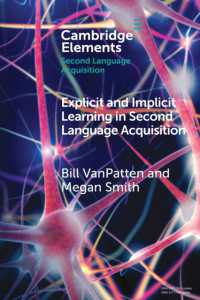- ホーム
- > 洋書
- > 英文書
- > Science / Mathematics
Full Description
How can the efficiency of the algorithms be increased with a lesser number of computations as well as optimized with the resources for cost-effective solutions? Artificial Intelligence Techniques for Sustainable Development provides an answer. Further, it discusses important concepts such as green communication network design and implementation for the Internet of Things ecosystem, green computing in network security, and artificial intelligence models for remote sensing applications.
Key features:
Presents the latest tools and techniques in developing solutions intended for resource utilization, energy efficiency, and human and environmental health
Highlights the advancement in electronics and communication technology for green applications
Covers smart energy harvesting/charging and power management techniques using machine learning
Explains green communication network design and implementation for the Internet of Things ecosystem, and green computing in network security
Illustrates prediction models for carbon emission and sequestration, environmental health, and climate change
The book is aimed at senior undergraduates, graduate students, and academic researchers in the fields of electrical engineering, electronics, and communications engineering, computer science and engineering, environmental engineering, and biomedical engineering.
Contents
Part 1: Introduction to Artificial Intelligence in Green Technology. 1. Introduction to Green and Red Artificial Intelligence. 2. Impact of Artificial Intelligence Techniques on Green Applications. 3. Tools for Artificial Intelligence in Green Applications. 4. Artificial Intelligence for Human-Computer Interfaces. Part 2: Green Electronic Technology. 5. Green Communication Technologies and Protocols. 6. Green Communication Network Design and Implementation for Internet of Things Ecosystem. 7. Smart Portable and Intelligent Internet of Things Enabled System for Green Applications. 8. Green Computing in Network Security. 9. Artificial Intelligence Models for Remote Sensing Applications. Part 3: Green Energy Technology. 10. Energy Efficiency Models of Artificial Systems. 11. Artificial Intelligence for Energy Storage Systems. 12. Smart Energy Harvesting/Charging and Power Management Techniques using Machine Learning. 13. Renewable Energy Monitoring and Forecast based on Intelligent Data Analysis. 14. Case Study on Artificial Intelligence Integration with Green Energy Generation. Part 4: Green Environmental Solutions. 15. Green Artificial Intelligence: Biodegradable and Biocompatible Materials. 16. Artificial Intelligence in Nanotechnology for Green Applications. 17. Virtually Going Green: The Role of Artificial Intelligence in Reducing Pollution and Toxicity. 18. Prediction Models for Carbon Emission and Sequestration. 19. Prediction Models for Environment Health. 20. Predictions Models for Climate Change or Natural Disaster. 21. Air Pollution Control. 22. Water Security and Ocean Technology. 23. Case Study: Maintenance of Water Quality in Different Geographic Locations. Part 5: Green Healthcare. 24. Digital Health Solutions with Bionic Devices. 25. Smart Biomaterials. 26. Remote Health Monitoring and Telehealth. 27. Optimization of Biomedical Devices using Machine Learning and Deep Learning. 28. Prediction Modules for Biomedical Signal Processing. 29. Case studies: Healthcare Monitoring Systems.







